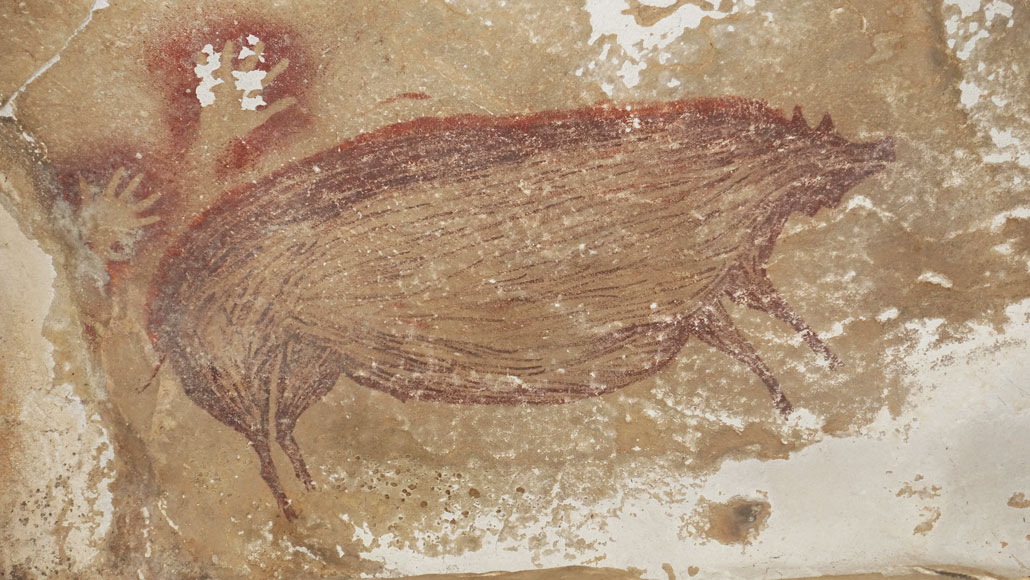I was fascinated to read this article about the study of fossilized footprints in New Mexico’s White Sands National Park.
A small woman—or perhaps an adolescent boy—walks quickly across a landscape where giant beasts roam. The person holds a toddler on their hip, and their feet slip in the mud as they hurry along for nearly a mile, perhaps delivering the child to a safe destination before returning home alone.
Despite the fact that this journey took place more than 10,000 years ago, a new paper published in the journal Quaternary Science Reviews manages to sketch out what it might have looked and felt like in remarkable detail.
Evidence of the journey comes from fossilized footprints and other evidence discovered in New Mexico’s White Sands National Park in 2018, reports Albuquerque TV station KRQE. Toward the end of the late Pleistocene epoch—between 11,550 and 13,000 years ago—humans and animals left hundreds of thousands of tracks in the mud along the shore of what was once Lake Otero.
The article explains how experts in footprint forensics have deduced a huge amount of information from the footprints. Here children jumped over puddles left from the footprints of a giant sloth. There mammoths crossed the path of the humans taking no notice. Here a sloth, perhaps sensing the presence of humans stood up on its back feet for a moment to sniff the air.
The footprints remain of the mysterious humans who lived in New Mexico so many eons ago and it reminds me of the passage in G.K.Chesterton’s The Everlasting Man where he discusses the conventional picture of the cave man as being a simian, inarticulate brute whereas in fact, the one thing we really do know about the cave man, from the cave paintings at Lascaux–and recently discovered in Indonesia is that he was an artist.
In Mircea Eliade’s work on world religions he observes that the very little information we have about the most primitive human beings is from the information gathered by archeologists when they open the tombs of the prehistoric humans. What they find is evidence of artistry, craftsmanship and religion. Artistry and craftsmanship in the weapons, crowns and ornaments that are buried with the long lost kings and evidence of religion in that they were clearly buried according to some sort of ritual and with a belief in the afterlife–that they were buried with bowls of food, some of the marks of their status or amulets and trinkets for their journey to the other side.
Ancient man was therefore not so different, at heart from us. In fact, a good argument can be made that they were, in some ways, more advanced than us. They may not have had cell phones and jet planes and the internet, but they understood their connections with the earth, with the stars and the heavens in an intuitive way that we have lost. I’m not falling into the “noble savage” fallacy here–if they had some knowledge we don’t have they also have the brute instincts we have. Graves are found of warriors with arrow still in them and others suffering from horrible wounds of torture and battle.
By the way, why not take a break today and read (or re-read) this great chapter from Chesterton’s classic? You can find it here:
The point of Chesterton’s chapter is that the idea of primitive man as being so very different (and inferior) to us is a narrative dependent on various philosophies that undermine our modern, secular world. One is Darwinism and along with this the poison of progressivism–both of these philosophies assume an unrelenting upward surge of nature until at last we reach the climax of perfection: modern man. Everything else was brutal, basic and animalistic until we reach you and me who are just wonderful.
At the same time we are led to believe in Roussau’s idea of the noble savage–that the tribal person living in primitive conditions in the jungle is somehow more noble than we are. He has not been corrupted by society and “shock horror”! organized religion.
Whenever you find two ideas that are absolutely contradictory abiding within the same ideology you know you are looking at a diabolical lie. Satan always does this. He loves to play with two hands and will slip in one lie that contradicts the other and you’re not supposed to notice.
The simple fact is that a human is a human is a creation of God in his image and likeness. Whether they are low tech children hop skipping and jumping over the footprints of giant sloths or ancient Britons building Stonehenge to chart the movements of the stars or techies in Silicon Valley making the latest smart phone–we are all children of the heavenly father–part ape and part angel–all fallen into the gutter but gazing at the stars, all created good, but needing salvation.







Thank you for this wonderful and thoughtful post. Really one that should be read by everybody. God bless.